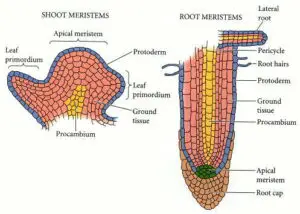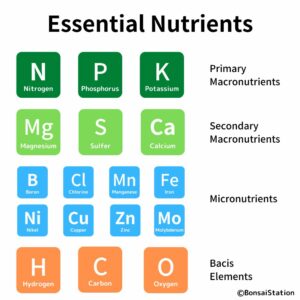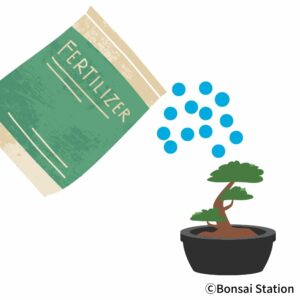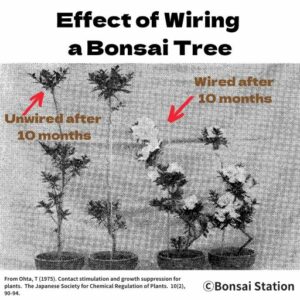Understanding the process of flowering and its influencing factors is essential for bonsai growers like you because it enables to encourage your bonsai trees to bloom and allows to provide the proper care that can prevent interferences to flowering.
I believe that this knowledge enhances the joy of your flowering bonsai cultivation journey.
What is flowering?
Definition of flowering
Flowering is the biological process in plants where the transition from vegetative growth (producing leaves and stems) to the reproductive phase (producing flowers) takes place.

Apical meristem: Shoots, flowers and roots develop from the same organ.
(Source: Gilbert SF. Developmental Biology. 6th edition. Sunderland (MA): Sinauer Associates; 2000. Vegetative Growth.)
Vegetative growth or shoot growth occurs at the tip of the stem in an area called apical meristem. This is a mass of undifferentiated cells that can be differentiated to either form stems/leaves or flowers at the right cues.
Process of flowering
The process of flowering is a cascade reaction consisting of several steps, which are in essence intricate biological events. These steps can be broken down into the following 6 stages.
- Flower bud initiation
- Flower bud development
- Dormancy
- Flower bud maturation
- Flower bud opening
- Full bloom
Let me break it down for you step by step so that it can be easily understood.
Please note that here, I am speaking about “traditional” flowering bonsai tree species like azalea, cherry blossom and wisteria. Other species, especially ones that grow in tropical climates, may go through different stages.
Flower bud initiation
The first stage in the blooming process is flower bud initiation. This occurs when the tree receives specific signals, either internally or externally, which trigger reproductive growth.
Flower bud development
After initiation, the flower buds start to develop. The flower buds undergo cell division and differentiation to form specialized structures like pistils within the buds.
Dormancy
For bonsai trees that bloom in spring, flower bud development that is initiated in summer is almost or fully suspended by winter cold. During winter, the cold temperatures trigger various physiological responses in trees, which leads to the interruption of flower development.
Flower bud maturation
After dormancy, the flower buds complete their development and all the floral organs are fully formed within the bud. The bud is now ready to open into a flower.
Flower bud opening
External cues, such as daylight, temperature changes, or the presence of pollinators, trigger the flower opening process.
Full bloom
This is the moment of full bloom when the flower is completely open, releasing fragrances to attract pollinators. The stamens release pollen, and the pistil is ready to receive pollen for fertilization.
Factors affecting flowering
Flowering can be stimulated by internal and/or external cues.
Internal factors
Internal cues include factors such as plant age or size. The internal cues enable plants to regulate flowering when a plant is at optimal size or age.
External factors
External cues, on the other hand, include environmental stimuli:
- temperature,
- day/night length,
- nutrition,
- water, and/or,
- stress.
The external cues allow plants the optimal timing of flowering during a year to ensure successful pollination and seed development.
Internal factors of flowering
Life cycle
Every living organism passes through a series of developmental phases during growth and maturation. Unlike animals, the transition from the young to the mature phase for plants only takes place at the tip of the stem called apical meristem and not the whole plant body.
The life cycle of a tree can be divided into three main phases:
- juvenile,
- adult vegetative, and
- adult reproductive.
Juvenile phase
In the juvenile phase, the tree is young and not yet capable of flowering.
During this phase, the meristem does not have the ability to produce flowers. The tree focuses on growing leaves and stems to establish itself and build energy reserves for future development.
Adult vegetative phase
As the tree matures, it enters the adult vegetative phase.
In this stage, the meristem becomes competent, meaning it has the potential to produce flowers if certain conditions are met. However, the meristem has not yet been triggered or induced to initiate flower development.
Adult reproductive phase
When certain internal or external cues are present, the tree’s meristem is signaled to produce flowers.
During this stage, the meristem undergoes a process called floral induction, which leads to the development of flower buds and eventually the formation of flowers.
Transition
The tree is only capable of flowering at the adult reproductive phase and you might be wondering what triggers the transition. Time can, of course, be a factor but what else?
In fact, the transition from juvenile to adult phases can be influenced by a number of factors including species and environment.
Species
Different species have varying lengths of the juvenile phase.
Generally, species that live longer have a longer juvenile phase. For example, certain nut trees have a juvenile phase lasting up to 25 years while some annual plants have a very brief juvenile phase of around 2 weeks.
The following table shows the length of the juvenile period of some bonsai trees.
Juvenile phase length of woody plants
| Species | Juvenile period length |
| Rose | 20-30 days |
| Apple (Malus spp.) | 4-8 years |
| Redwood (Sequoia sempervirens) | 5-15 years |
| Sycamore maple (Acer pseudoplatanus) | 15-20 years |
| English oak (Quercus robur) | 25-30 years |
| European beech (Fagus sylvatica) | 30-40 years |
(Source: Erwin, J. (2006). Factors affecting flowering in ornamental plants. In Flower Breeding and Genetics: Issues, Challenges and Opportunities for the 21st Century (Vol. 9781402044281, pp. 7-48). Springer Netherlands.)
Environment
Environmental conditions can both accelerate or decelerate the transition from the juvenile to the adult phase.
For instance, many species’ juvenile period length can be reduced by the addition of supplemental lighting. On the contrary, low sunlight can delay the transition from the
juvenile to the adult phase or can even cause reversion from the adult back to the juvenile
phase.
External factors of flowering
As mentioned earlier, the external cues allow bonsai trees the optimal timing of flowering during a year to ensure successful pollination (and potential seed development).
Temperature

Temperature plays a significant role in flower formation for flowering bonsai trees. Each species has an optimal temperature range for flower initiation and development.
While the specific temperature required for flower bud initiation remains uncertain, we know a certain temperature range optimal for flowering for the “traditional” flowering bonsai trees that develop flower buds in summer.
Optimal temperature for flower bud initiation
Temperatures between 59°F to 68°F (15°C to 20°C) are optimal for flower bud initiation, although most flowering bonsai trees start to produce flower buds in summer, which I think is hotter than this optimal temperature in most of the regions. Mid-summer high temperatures do in fact delay flower bud initiation.
There is a lower limit as well: temperatures lower than 10°C (50°F) will inhibit flower bud initiation.
Optimal temperature for flower bud development
The optimum temperature range for flower bud development is around 59°F to 68°F (15 to 20°C) during the early stage and may fall to around 50°F to 41°F (10°C to 5°C) in the later stage.
The temperature range allowing optimal flower bud development has both upper and lower limits. The upper limit is 77°F (25°C) during the initial stage and the lower limit is 32°F to 41°F (0°C to 5°C).
The optimum temperature decreases as flower buds continue to develop. This may be due to the tree’s adaptation to the seasonal change in the natural environment. The upper limit now decreases to 68°F (20°C) or lower. Eventually, it may fall to around 10°C to 5°C (50°F to 41°F) in the later stage, depending on the species.
It is worth noting that exposure to low temperatures at specific developmental stages of flower buds can promote blooming, though the effectiveness depends on the species and the timing of exposure.
Optimal temperature for flower opening
Flower buds stop developing in winter but they rapidly resume development and mature when they are exposed to suitable temperatures after experiencing colder conditions. When the temperature meets the required level for maturity, these flower buds bloom.
The ideal flowering temperature varies depending on the type of tree but for most tree species, it is within the range of 50°F to 68°F (10° to 20°C).
For instance, azaleas and camellias bloom around 68°F (20°C), cherry blossoms and wisteria prefer 59°F to 68°F (15° to 20°C), while plums and Japanese quince bloom in temperatures of 50°F to 59°F (10° to 15°C).
If the temperature falls below this range, flowering may be delayed and when it drops below 41°F (5°C), flowering might hardly occur. Higher temperatures above 77°F (25°C) lead to early flowering but the quality of the flowers might suffer.
Day/night length

What is photoperiod?
For many plants, one of the key factors influencing flower bud initiation is the duration of light and darkness they receive within a 24-hour period, known as the photoperiod. This phenomenon can be seen in aminals like hibernation and migration.
Different plant species have distinct requirements regarding day length to initiate flower buds: short-day plants, long-day plants, day-neutral plants, intermediate-day plants
and ambi-photoperiodic plants.
Short-day plants are those that initiate flower buds when exposed to longer nights and shorter days. On the contrary, long-day plants require shorter nights and longer days to initiate flower buds. Day-neutral plants are those that are not affected by day/night length.
Photoperiod for bonsai trees
For most of the deciduous flowering bonsai species, however, the flower bud formation is NOT predominantly controlled by day/night length, meaning the change in daytime and nighttime is mostly irrelevant for flowering (source).
The exceptions for this neutrality to day/night time are evergreen flowering trees such as camellia (long-day) and Kurume azalea (short-day) (different azalea cultivars act differently to photoperiod).
Nutrition
The availability and balance of essential nutrients in the soil are crucial factors that influence flower bud initiation and development.
While phosphorus and potassium are widely recognized for their role in stimulating flowering, the level of nitrogen and when it is applied play a significant role in the blooming success of flowering bonsai.
Nutrition needs of bonsai trees

Like all plants, bonsai trees need the following nutrients for optimal growth and development.
-
- Nitrogen (N) for leaf growth
- Phosphorus (P) for energy transfer from leaves to flowers
- Potassium (K) for overall health and disease resistance
It is well known that P is important for flowering trees because it is involved in essential processes vital for flower formation and development. But nitrogen, which is responsible for leaf growth, also plays a significant role in the flowering process.
Importance of nitrogen level
While N is an essential nutrient required for leaf development, its availability and concentration in the soil significantly impact flowering behavior.
In fact, it is the nitrogen level applied to the bonsai tree that controls its transition from vegetative growth to reproductive growth and vice versa.
Too much nitrogen in the soil can lead to excessive growth of lush foliage at the expense of flower formation. With abundant nitrogen, the tree prioritizes leafy growth over the production of reproductive structures, such as flower buds.
Providing an appropriate balance of nutrients, including nitrogen, phosphorus, and potassium, on the other hand, will encourage both vegetative and reproductive growth. A well-balanced nutrient supply supports the development of healthy foliage while promoting the initiation and development of flower buds as well.
Importance of scheduling nutrient application

It is also important to know when these nutrients are applied. The timing of nutrient application is crucial, especially nitrogen, for successful flower bud formation.
Nitrogen should be applied at higher levels during the early stage of the growing season to promote vigorous vegetative growth that can help store enough carbohydrates for flowering.
Before the flower buds start to form in early summer, reduce nitrogen levels in the soil to promote the transition from vegetative growth to reproductive growth. This adjustment signals to the tree that it should focus on flower formation rather than continuing to produce new leaves and shoots.
Applying too much nitrogen or the presence of nitrogen in the soil at this stage can disrupt the flowering process as the plant may prioritize vegetative growth and delay or inhibit the formation of flower buds.
So, it is vital to carefully manage nutrient application and reduce nitrogen levels as the flower buds reach their critical developmental stage to enhance the chances of abundant blooming in bonsai trees.
For more information about fertilizing bonsai trees, the following post might be helpful.
Water

As a fundamental element in the life of plants, water is essential in cultivating healthy and robust bonsai trees. Water also plays a crucial role in flower bud development.
Surprisingly enough, mild drought stress at the flower bud initiation period can promote more numbers of flower buds, leading to higher blooming rates for bonsai trees.
When a tree experiences mild water stress, it may interpret this as a signal of potentially unfavorable conditions. It would then shift its priorities from vegetative growth to reproduction as producing seeds ensures the survival and propagation of the species.
Mild water stress can also lead to the accumulation of carbohydrates produced through photosynthesis as a survival mechanism. These high carbohydrate levels in tissues can be used as energy for more flower bud initiation and robust development.
The keyword here is “mild” water stress. As you can imagine, severe drought stress may lead to reduced flowering rates, delayed flowering, or even inhibit flowering altogether.
Stress
Short-term plant stress will cause a shortening of the juvenile phase and promote the induction of flowering.
In horticulture, it is well known that shoot bending towards or below the horizontal level is very effective in inducing increased numbers and quality of floral buds in apple trees (source here).
The exact mechanism behind this effect is not fully understood but it is believed that shoot bending slows down new shoot extension, which may reduce the inhibitory plant hormones on flower bud formation.
This phenomenon is also seen in bonsai cultivation in regard to wiring.

Effect of wiring a bonsai tree
According to this scientific research when the trunk of a young azalea tree was wired, multiple fine branches developed very quickly with flowers blooming 10 months after wiring. The one without wiring grew vigorously but developed fewer branches and no flowers.
What happened to the wired azalea bonsai here is that the stress caused by bending the branches increased the production of plant hormones, which inhibited it from continuously growing upwards. It instead promoted the transition from the juvenile to adult phase without full growth.
By understanding the process of flowering and the factors affecting it, I am sure you can provide your bonsai trees with the necessary care to produce an abundance of beautiful and enchanting blooms.
—–
References
Erwin, J. (2006). Factors affecting flowering in ornamental plants. In Flower Breeding and Genetics: Issues, Challenges and Opportunities for the 21st Century (Vol. 9781402044281, pp. 7-48). Springer Netherlands.
五井正憲. (1982). 温帯花木の花芽形成ならびに開花調節に関する研究. 香川大学農学部紀要, 38, 1-120. (Goi, Masanori. (1981). Studies on the flower formation and forcing of some ornamental trees and shrubs native to East Asia, Kyoto University.)
Gilbert SF. Developmental Biology. 6th edition. Sunderland (MA): Sinauer Associates; 2000. Vegetative Growth.)



